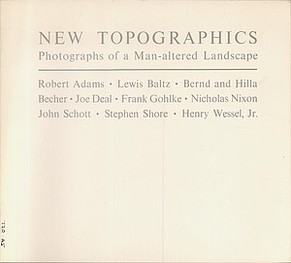 In 1975, an exhibition entitled 'New Topographics: Photographs of a Man-Altered Landscape' debuted at the George Eastman House International Museum of Photography in New York. It was the first public gathering of an original and subsequently highly influentual style of landscape photography. Ten artists working with a similar intent were selected by curator William Jenkins under a philosophy designed to more accurately represent the modern American landscape. The ten artists of the exhibition: Lewis Baltz, Joe Deal, Robert Adams, Frank Gohlke, Henry Wessel Jr, John Schott, Nicholas Nixon, Stephen Shore and Bernd and Hilla Becher, were all technically adept photographers with unique vision and an interest in aesthetic theory, and almost all went on to great success. Three of the artists were commissioned by the French government for the 'Mission de la DATAR', an agency that hired photographers to document the French landscape, and their combined influence on photography can still be seen today with many European and American photographers, such as Andreas Gursky, Nathan Ian Anderson and Toshio Shibata, emulating the style and philosophy of the exhibition. The exhibition was to be a counterpoint to the aesthetics of the traditional landscape photography of artists such as Ansel Adams, Edward Weston or Timothy O’Sullivan, which Jenkins argued was compromised by an overly romanticised and restrictive view of America. This rebellion against what they considered to be an archaic form of photography attempted to be all encompassing; the artists proposed a different approach to almost all aspects of composition, presentation and subject matter in their work. The vision of this new collective was to present work that expressed modern America with neutrality and a lack of judgement or, as Jenkins puts it, "[eschewed] entirely the aspects of beauty, emotion and opinion". This was an unrealistic aim, as ‘entirely’ eschewing these aspects would surely prevent promoting these works as valuable and nullify the arguments put forward by the artists regarding consumption and ecology. Therefore, upon examination, the proposal seems disingenuous, but it was likely proposed as inspiration for a particular focus rather than as a true goal. The alignment with the historical or scientific field of topography rather than another art movement or aesthetic principle represented an attempt to distance the work from the commonalities of landscape photography. However, the artists did take inspiration from a wide variety of sources in photography: Edward Ruscha (in particular his books "Twentysix Gasoline Stations" and "Thirtyfour Parking Lots"); Robert Frank and Walker Evans were explicitly mentioned by Jenkins as influences; Dorothea Lange, Eugène Atget, and Minor White could also be seen as guiding forces. These social realist and landscape photographers focused on the sections of American society and environment which were, in the opinion of the New Topographers, greatly unappreciated. It is no coincidence that the New Topographers were inspired by the social realist photographers working during the Great Depression. When the depression hit in the late 1920's, photographers such as Dorothy Lange and Walker Evans chose subject matter that most clearly defined the times and represented the effects of the economic crisis. In documenting the shanty towns of poverty stricken migrant workers and the commercial iconography that held a bitter irony, they impressed upon the viewer the diminishing belief in the American Dream. These photographers sought to highlight social issues and explore connections between humans and their environment (e.g. Lange and Evans’ dust-bowl portraits and landscapes) with people and the land presented as intrinsically connected. This could be said to be similar to the New Topographers' portrayal of the post-Vietnam period, in which mistrust of government and inflation were also at a high. The New Topographers were representing the cynicism of the mid-to-late 1970's through their own interpretation of the relationship between culture and landscape, focusing on how human development throughout the century had altered the landscape. Lewis Baltz's stark images juxtaposed the beauty of the built environment with the contrary ugliness inherent in industrial tracts and national parks, littered with abandoned detritus, symbolising what many saw as problems of the modern age: the negative effects of capitalism and the unusual aesthetic value of often overlooked (sub)urban areas. The suburban expansion and exploitation of nature that informed the work of the New Topographers were aspects of development that were also seen as potentially disastrous by many members of the public, following the gradual mainstream acceptance of the previously counter-cultural concerns of environmental groups such as Greenpeace and Friends of the Earth. The New Topographers presented familiar objects of the American landscape in a reductivist style. The presentation was intentionally spare, as were the titles, and they assembled the photos so as to encourage the viewer to see the works as document rather than art. Some of the photographers abandoned the traditional placement of the horizon in the middle of the frame and occasionally a horizon was completely nonexistent, emphasising confinement in landscapes that were commonly represented as boundless. Jenkins summed up the intent of the method of presentation when he said that the exhibition was "anthropological rather than critical, scientific rather than artistic". 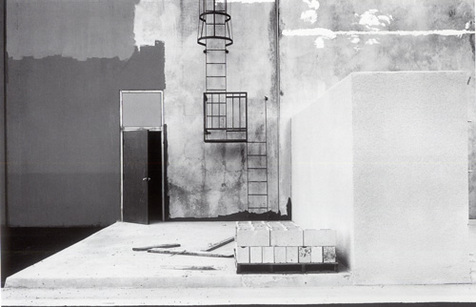 Lewis Baltz, South Wall Xerox Element #27 The New Industrial Parks Near Irvin, CA 1975. Lewis Baltz, South Wall Xerox Element #27 The New Industrial Parks Near Irvin, CA 1975. Lewis Baltz and Bernd and Hilla Becher were the artists that pushed this method of reductivism to its zenith. Baltz produced small, predominantly square, grey tone prints that displayed fascinating texture and geometry. Often these were very minimalistic shots of industrial buildings taken at eye level parallel to a wall, or desert panoramas interrupted by human detritus. His work appeared very detached and clinical, but this was how Baltz saw the modern relationship of man and nature; as detached as the viewer is to the objects reproduced. The aloof objectivity was ironic comment. 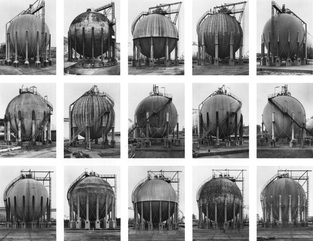 Bernd and Hilla Becher, Gas Tanks, 1983-92. Bernd and Hilla Becher, Gas Tanks, 1983-92. Bernd and Hilla Becher also mainly focused on industry, their work was often presented as a series of small images of industrial buildings, or contraptions of the same function placed 3x3 or 3x6 in a frame. This repeated pattern of almost identical objects from around the country conveyed mixed feelings towards urban development and industrialisation. The viewer simultaneously sees the uniformity of the built environment yet also the unusual beauty of the objects separated from their usual context. Robert Adams is perhaps the most well known of all the New Topographers, and the one artist whose work best encapsulated the whole message of ecological conservation and the difficult relationship between humans and the natural environment. 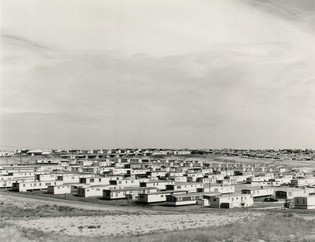 Robert Adams, Untitled, Denver 1970-74 Robert Adams, Untitled, Denver 1970-74 'Untitled, Denver 1970-74' is one of Adams' most evocative photographs of the rapidly expanding Denver metropolitan area, showing a vast field of constricted tract housing right up to the horizon with a strip of empty desert at the bottom of the frame. This composition emphasises the speed and aggression of the urban development and the figurative and literal delineation between two worlds; the free wilderness and the restrained city. Adams' work on the ecological theme of the New Topographers message was very powerful. Photographs such as those of individual trees stranded amongst signs of development (roads, agriculture etc.) created an oppressive atmosphere and communicated that this modern development has the force of an invasion. Stephen Shore stood out from the rest of the New Topographers as he was the only one at the time to work predominantly in colour and use more established, formal techniques. Employing a large photographic camera with a film size of 8 x 10 inches (20 x 25 cm), he furthered the artistic legitimacy of colour photography with his vibrant scenes of sparsely populated America. In addition, by producing direct positive copies of the colour negatives, his photographs were incredibly detailed. 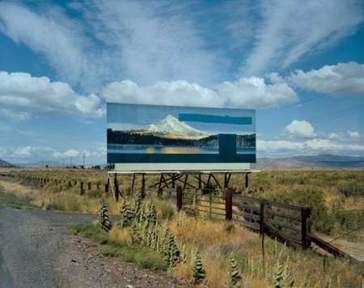 Stephen Shore, U.S. 97, South of Klamath Falls, Oegon July 21, 1973 Stephen Shore, U.S. 97, South of Klamath Falls, Oegon July 21, 1973 'U.S. 97, South of Klamath Falls, Oegon July 21, 1973' exemplifies Shore's use of colour and the particularly processed large format film, which retains all the sharpness and vividness of the billboard image so as to better convey the intended message. The natural landscape of America is obstructed by a reproduction, the absurdity of which perfectly communicates the central question of the New Topographers: what is the essential American landscape in modern America? Equally as impressive as the conceptual nature of the photograph is the well-composed synchronicity of the clouds and the billboard's edges, leading our eyes directly into the false scene as if nature itself were pointing out the irony. This decidedly more playful and affectionate view of the changing landscape of America can also be seen in his work displaying everyday small-town subject matter, such as truck stops, parking lots and seemingly homogeneous main streets that exhibit stereotypical elements that belie the idiosyncrasies in the details. The New Topographers work bridged the gap between documentary photography and the conceptual art of the sixties and seventies. Their photographs communicated the confusing mixture of beauty and ugliness in the built environment and the pressures placed on nature in urban expansion, which developed into a style that was widely influential. While their maxims of absolute objectivity and rejection of beauty were deceptive, they did follow through on their expressed intention to represent America in a more honest and pragmatic manner and encourage a conservational examination of the relationship between humans and nature. By Kieran Gosney References Robert Adams, Lewis Baltz, Bernd and Hilla Becher, Stephen Shore et al, New Topographics: Photographs of a Man-Altered Landscape, 1975 Dennis, Kelly, Landscape and the West: Irony and Critique in New Topographic Photography, University of Connecticut, USA, April 2005
3 Comments
29/10/2013 10:30:40 pm
This amazing article content writing on topic photography .i read completely so nice piece of writing.
Reply
18/1/2015 03:17:13 am
Very nice, you speaking on : DATAR PROJECT !!! I am photographer on '' DATAR Project ''.
Reply
16/1/2016 09:09:19 am
This post is what I consider a well thought out posting. Distinct as well as the point. I will have to certainly watch out for more posts such as this.
Reply
Leave a Reply. |
Archives
November 2023
Categories
All
LinksWriting
Art & Design Science Music Film All contributions by Kieran Gosney unless otherwise stated.
© Kieran Gosney and kierangosney.com, 2013. Unauthorized use and/or duplication of this material without express and written permission from this blog’s author and/or owner is strictly prohibited. Excerpts and links may be used, provided that full and clear credit is given to Kieran Gosney and kierangosney.com with appropriate and specific direction to the original content.
|
 RSS Feed
RSS Feed